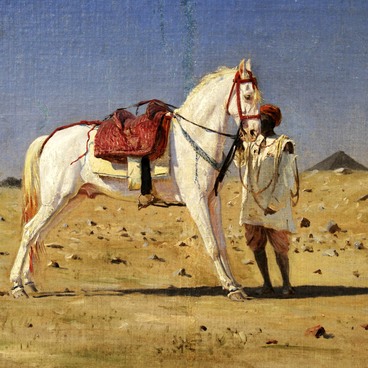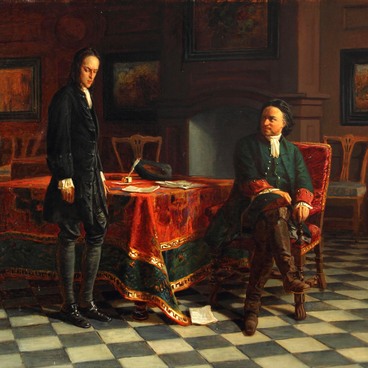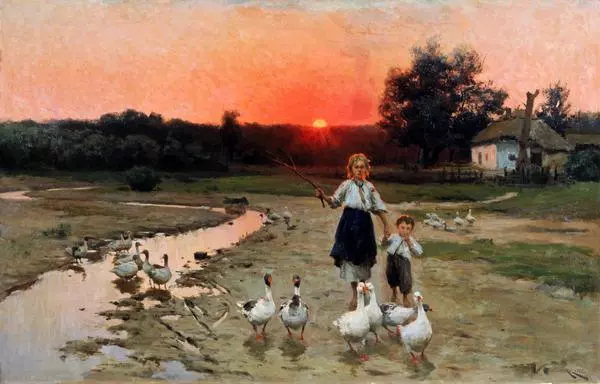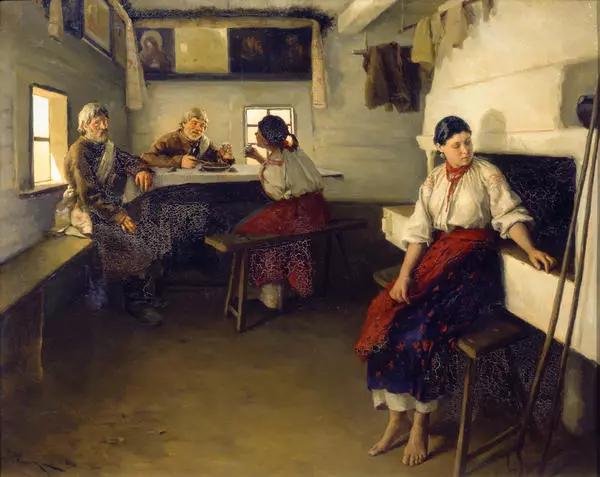Russian-Ukrainian painter Mykola Pymonenko was born in 1862 near Kiev in the family of a wood carver. At first, he studied at the icon-painting school under the Kiev-Pechersk Lavra, and later became a student of the Kiev Drawing School. In 1882, he entered the Academy of Arts, where he studied as a free-listener in the class of Vladimir Orlovsky - an outstanding Russian landscape painter. The northern climate badly affected the health of Pymonenko, and he had to return to Kiev, and did not graduate from the academy. Here he taught and continued to search for his way in the world of painting.
In the 1880s, Pymonenko was actively exhibited at academic exhibitions. By the end of the decade, the main theme in his work was the image of life in a Ukrainian village. He painted everyday life and work of ordinary people in poetic tones, often genre painting and expressive landscapes met in his works.
This combination is also used in the 1891 painting Easter Morning in Malorossiya: the religious holiday here is depicted against the background of a peaceful landscape. Pymonenko can rightfully be called a master of light effects: the warm light from the many candles combined with the pre-dawn haze conveys a rich palette of feelings experienced by the participants of the great Christian holiday.
The obligatory attributes of Easter - cakes and colored eggs - complement the mood of general joy and celebration. At the same time, Pymonenko did not try to idealize his heroes: someone never waited for the morning service and fell asleep, tired children play, and women talk about something of their own. The motive of the spring revival is underlined by the touching figure of a girl standing by a small tree with delicate white flowers - her face is illuminated by the rays of the dawn sun.
The great interest to national traditions, and also a life and folklore of the simple people unites painting of Pymonenko with national-romantic trends, which have gained force in the Russian art of the end of the 19th century - in architecture and decorative-applied art they have formed in so-called ‘Russian style’. The artist’s interest in folk themes was quickly noticed by the Itinerants: in 1899 he was accepted as a full member of the comradeship. And in 1904 he was granted the title of academician of painting.
In the 1880s, Pymonenko was actively exhibited at academic exhibitions. By the end of the decade, the main theme in his work was the image of life in a Ukrainian village. He painted everyday life and work of ordinary people in poetic tones, often genre painting and expressive landscapes met in his works.
This combination is also used in the 1891 painting Easter Morning in Malorossiya: the religious holiday here is depicted against the background of a peaceful landscape. Pymonenko can rightfully be called a master of light effects: the warm light from the many candles combined with the pre-dawn haze conveys a rich palette of feelings experienced by the participants of the great Christian holiday.
The obligatory attributes of Easter - cakes and colored eggs - complement the mood of general joy and celebration. At the same time, Pymonenko did not try to idealize his heroes: someone never waited for the morning service and fell asleep, tired children play, and women talk about something of their own. The motive of the spring revival is underlined by the touching figure of a girl standing by a small tree with delicate white flowers - her face is illuminated by the rays of the dawn sun.
The great interest to national traditions, and also a life and folklore of the simple people unites painting of Pymonenko with national-romantic trends, which have gained force in the Russian art of the end of the 19th century - in architecture and decorative-applied art they have formed in so-called ‘Russian style’. The artist’s interest in folk themes was quickly noticed by the Itinerants: in 1899 he was accepted as a full member of the comradeship. And in 1904 he was granted the title of academician of painting.





